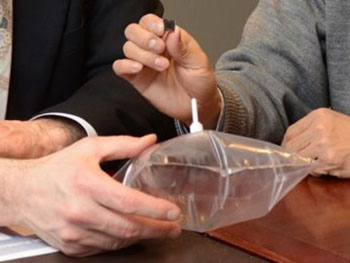Breath Test May Improve Lung Cancer Screening and Monitoring
By LabMedica International staff writers
Posted on 20 Jun 2016
Researchers have found that a biomarkers signature of four volatile organic compounds (VOCs) in breath facilitates earlier diagnosis of lung cancer and simple non-invasive monitoring of treatment effectiveness.Posted on 20 Jun 2016
Exhaled breath contains thousands of VOCs that vary in composition and pattern depending on, for example, a person’s health status. A subset of 4 carbonyl VOCs have been discovered in the exhaled breath of lung cancer patients. Being able to identify this lung cancer “signature” through a simple breath test has emerged as one of the most promising ways to diagnose the disease. Now the test is being used to monitor for disease recurrence after surgery.

Image: Scientists have discovered a simple test that may someday help diagnose lung cancer earlier by analyzing exhaled breath (Photo courtesy of the University of Louisville).
Erin M. Schumer, MD, MPH, Victor van Berkel, MD, PhD, and colleagues from the University of Louisville (Louisville, KY, USA) analyzed breath samples collected before and after surgery from 31 lung cancer patients and compared their carbonyl VOCs levels with samples from 187 healthy patients. The researchers found a significant decrease in overall carbonyl VOC levels following surgery, and 3 of the 4 carbonyl VOCs normalized after surgery, matching levels in the control group.
“The rapid normalization of almost all of the four compounds after surgery provides strong evidence that they are directly produced by the tumor environment,” said Dr. Schumer, “This study confirms that the technology is accurate.” Dr. Schumer underscore the need for early detection: “We hope that breath analysis will allow us to diagnose patients with primary or recurrent lung cancer long before they suffer from symptoms, when we have more options for treating them.” Furthermore, lung cancer patients are currently followed after surgery with chest computed tomography (CT) scans, which can be inconvenient, expensive, and expose the patient to radiation. “We hope that the breath analysis can serve as the primary screening tool for cancer recurrence and a CT scan ordered only if the breath test suggests that there has been a change,” said Dr. van Berkel.
In the simple procedure the patient blows a single breath into a specialized balloon, so breath collection can be performed in the physician’s office. The balloon is then connected to a pump that pulls the breath over a microchip, which traps the chemicals. The microchip is sent to the lab for chemical analysis, results are provided within hours. The pump is reusable; the balloon, microchip, and lab test together cost around USD 20, supporting the increasing acceptance of breath tests as a cost-effective, easy-to-perform, non-invasive, and rapid tool in diagnosis and monitoring.
“The technology is pretty robust. Our next step is getting approval from the FDA,” said Dr. van Berkel.
The study, by Schumer E et al, was published June 9, 2016, in the Society of Thoracic Surgeons’s journal The Annals of Thoracic Surgery.
Related Links:
University of Louisville













